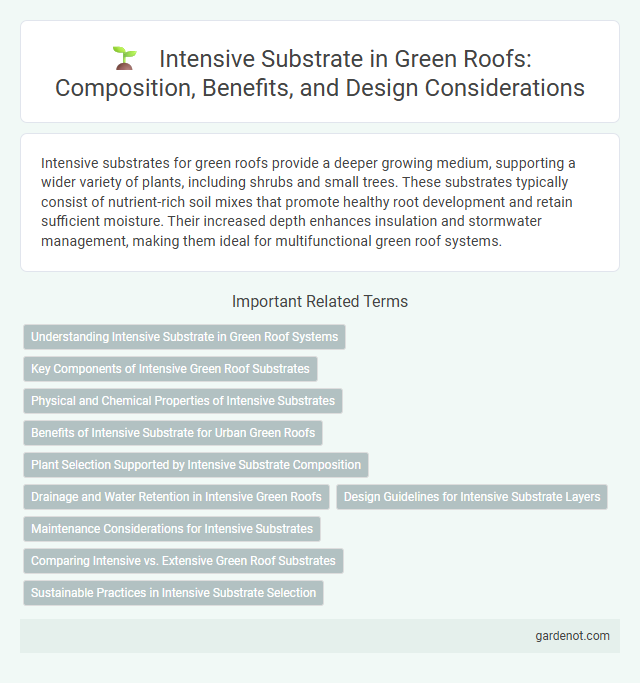Intensive substrates for green roofs provide a deeper growing medium, supporting a wider variety of plants, including shrubs and small trees. These substrates typically consist of nutrient-rich soil mixes that promote healthy root development and retain sufficient moisture. Their increased depth enhances insulation and stormwater management, making them ideal for multifunctional green roof systems.
Understanding Intensive Substrate in Green Roof Systems
Intensive substrates in green roof systems consist of deep, nutrient-rich growing media that support a diverse range of plants including shrubs and small trees. These substrates typically have a depth of 6 inches or more, providing sufficient water retention and root space for intensive vegetation. Proper composition of intensive substrates enhances structural stability, promotes biodiversity, and improves stormwater management on green roofs.
Key Components of Intensive Green Roof Substrates
Intensive green roof substrates typically consist of a soil mix rich in organic matter, minerals, and drainage materials such as expanded clay or perlite to support deep-rooted plants and trees. Key components include a balanced nutrient profile with adequate nitrogen, phosphorus, and potassium to sustain diverse vegetation, alongside moisture-retentive elements like compost or peat moss for water retention. Proper aeration is ensured through aggregate particles, enhancing root growth and preventing waterlogging in intensive green roof systems.
Physical and Chemical Properties of Intensive Substrates
Intensive substrates for green roofs possess high nutrient retention and excellent water-holding capacity, enabling the support of diverse plant species. Their physical properties include a deeper, denser composition with larger particle sizes, which promotes root growth and enhances aeration and drainage. Chemically, these substrates exhibit balanced pH levels and sufficient organic matter content, optimizing nutrient availability and fostering a stable growing environment.
Benefits of Intensive Substrate for Urban Green Roofs
Intensive substrates provide deep, nutrient-rich soil layers that support diverse plant species, enhancing biodiversity on urban green roofs. Their high water retention capacity reduces stormwater runoff, mitigating urban flooding risks and easing pressure on drainage systems. The substantial substrate depth also improves thermal insulation, lowering building energy consumption and contributing to urban heat island mitigation.
Plant Selection Supported by Intensive Substrate Composition
Intensive substrates support a diverse range of plant species by providing greater soil depth and nutrient availability, essential for deep-rooted shrubs and small trees. The composition typically includes a mix of organic matter, sand, and mineral components, ensuring optimal water retention and aeration to sustain heavy vegetation. Selecting plants that thrive in nutrient-rich, well-drained substrates maximizes green roof biodiversity and structural performance.
Drainage and Water Retention in Intensive Green Roofs
Intensive substrates in green roofs are engineered to balance drainage and water retention, ensuring optimal plant health and structural stability. These substrates typically contain a mix of organic matter and mineral components, such as expanded clay or pumice, which enhance water holding capacity while preventing waterlogging through efficient drainage layers. Proper substrate composition supports root aeration and nutrient availability, crucial for sustaining diverse vegetation in intensive green roof installations.
Design Guidelines for Intensive Substrate Layers
Intensive substrate layers for green roofs require a minimum depth of 150-300 mm to support a wide variety of plant species including shrubs and small trees. Design guidelines emphasize proper drainage, load-bearing capacity, and soil structure to ensure root development and water retention, while preventing compaction and erosion. Incorporating organic matter and balanced nutrient content optimizes substrate performance for long-term vegetation health on intensive green roofs.
Maintenance Considerations for Intensive Substrates
Intensive substrates in green roofs require regular maintenance including irrigation, fertilization, and pruning due to their deeper soil profile supporting diverse vegetation. Monitoring soil moisture levels and nutrient content is critical to prevent plant stress and ensure long-term roof performance. Proper maintenance schedules help manage weight loads and drainage, preserving structural integrity.
Comparing Intensive vs. Extensive Green Roof Substrates
Intensive green roof substrates typically range from 6 to over 12 inches in depth, supporting a broad variety of plant species including shrubs and small trees, whereas extensive substrates are usually 2 to 6 inches deep and mainly sustain drought-resistant, low-maintenance vegetation like sedums. Intensive substrates are heavier, often exceeding 80 pounds per square foot when saturated, demanding stronger structural support compared to the lighter weight (15 to 50 pounds per square foot) extensive options. The choice between intensive and extensive substrates hinges on goals related to biodiversity, structural capacity, irrigation needs, and cost considerations, with intensive systems offering greater ecological benefits at higher installation and maintenance commitments.
Sustainable Practices in Intensive Substrate Selection
Intensive substrates in green roofs prioritize sustainable practices by incorporating recycled materials such as crushed bricks, composted organic matter, and expanded clay, which reduce reliance on virgin resources and enhance soil fertility. These substrates optimize water retention and drainage, supporting diverse plant species while minimizing irrigation needs. Selecting locally sourced components further lowers carbon emissions associated with transportation, contributing to environmentally responsible rooftop ecosystems.
Intensive substrate Infographic

 gardenot.com
gardenot.com